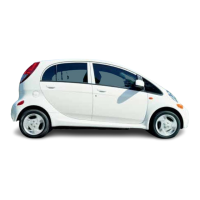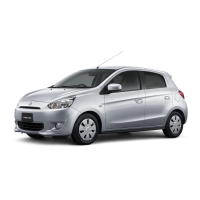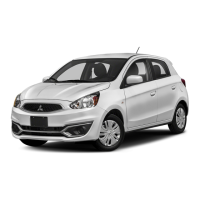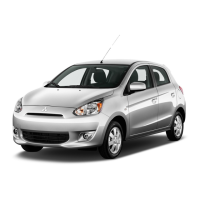Chapter 1 Tune-up and routine maintenance
4.19 Keep the brake and clutch fluid levels near the upper or
MAX marks on the reservoir-fluid can be added after
unscrewing the cap
15 In milder climates, plain water can be used in the reservoir, but it
should be kept no more than 2/3 full to allow for expansion if the water
freezes. In colder climates, use windshield washer system antifreeze,
available at any auto parts store, to lower the freezing point of the fluid. Mix
the antifreezewith water in accordance with the manufacturer’sdirections
on the container. Caution: Don’t use cooling system antifreeze -it will
damage the vehicle’s paint.
16 To help prevent icing in cold weather, warm the windshield with the
defroster before using the washer.
Battery electrolyte
17 To check the electrolyte level in the battery on conventional batteries,
remove all of the cell caps. If the level is low, add distilled water until it’s
above the plates. Most aftermarket replacement batteries have a split-ring
indicator in each cell to help you judge when enough water has been add-
ed - don’t overfill the cells!
Brake and clutch fluid
Refer to illustration 4.79
18 The brake master cylinder is mounted on the front of the power boost-
er unit in the engine compartment. The clutch cylinder used on some mod-
els with manual transmissions is mounted adjacent to it on the firewall.
19 The fluid inside is readily visible. The level should be between the up-
per and lower marks on the reservoirs (see illustration). If a low level is
indicated, be sure to wipe the top of the reservoir cover with a clean rag to
prevent contamination of the brake and/or clutch system before removing
the cover.
20 When adding fluid, pour it carefully into the reservoirto avoid spilling it
onto surrounding painted surfaces. Be sure the specified fluid is used,
since mixing different types of brake fluid can cause damage to the sys-
tem. See Recommendedlubricants and fluids at the front of this Chapter
or your owners manual. Warning: Brake fluid can harm your eyes and
damage painted surfaces, so be very careful when handling orpounng it.
Don
P use brake
fluid that b been standing open or is more than one year
old. Brake fluidabsorbs moisture from the air. Excess moisture can cause
a dangerous
toss
of brake efficiency.
21 Atthis timethefluidandmastercylindercan beinspectedforcontami-
nation. The system should be drained and refilled if deposits, dirt particles
or water droplets are seen in the fluid.
22 After filling the reservoir to the proper level, make sure the cover is on
tight to prevent fluid leakage.
23 The brake fluid level in the master cylinder will drop slightly as the
pads and the brake shoes at each wheel wear down during normal opera-
tion. If the master cylinder requires repeated additions to keep it at the
proper level, its an indication of leakage in the brakesystem, which should
be corrected immediately. Check all brake lines and connections (see
Section 23 for more information).
5.6 The automatic transmlsslon fluid level must be between the
two notches in the dipstick with the fluid at normal
operating temperature
24 If, upon checking the master cylinder fluid level, you discover one or
both reservorrs empty or nearly empty, the brake system should be bled
(Chapter 9).
5 Automatic transmission fluid level check
Refer to illustration 5.6
1 The automatic transmission fluid level should be carefully main-
tained. Low fluid level can lead to slipping or loss of drive, while overfilling
can cause foaming and loss of flurd.
2 With the parking brake set, start the engine, then move the shift lever
through all the gear ranges, ending in Neutral. The fluid level must be.
checked with the vehicle level and the engine running at idle. Note: Incor-m
reef fluidlevelreadings willresult if the vehicle has just been driven at high
speedsforan extendedperiod, in hot weather in city traffic, or/f it has been
pulling a trailer. If any of these conditions apply, wa/t until the fluid has
cooled (about 30 minutes).
3 With the transmission at normal operating temperature, remove the
dipstick from the filler tube. The dipstick is located at the rear of the engine
compartment on the passenger’s sfde.
4 Wipe the fluid from the dipstick with a clean rag and push it back into
the filler tube until the cap seats.
5 Pull the dipstick out again and note the fluid level.
6 The level should be between the two notches (see illustration).
7 If additional fluid is required, add itdirectly into the tube using a funnel.
It takes about one pint to raise the level from the lower notch to the FULL
notch with a hot transmission, so add the fluid a little at a time and keep
checking the level until it’s correct.
8 The condition of the fluid should also be checked along with the level.
If the fluid at the end of the dipstick is a dark reddish-brown
color, or
if it
smells burned, it should be changed. If you are in doubt about the condi-
tion of the fluid, purchase some new fluid and compare the two for color
and smell.
6 Power steering fluid level check
Refer to illustration 6.5
1 Unlike manual steering, the power steering system relies on fluid
which may. over a period of time, require replenishing.
2 The fluid reservoir for the power steering pump is located remotely
from the pump on the passenger’s side of the engine compartment.
3 For the check, the front wheels should be pointed straight ahead and
the engine should be off. The power steering fluid should be checked after
the vehicle has been driven and the fluid is at normal operating tempera-
ture.
4 Clean the cap and the area around the to prevent contamination of the
fluid,

